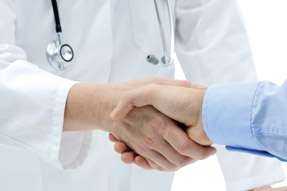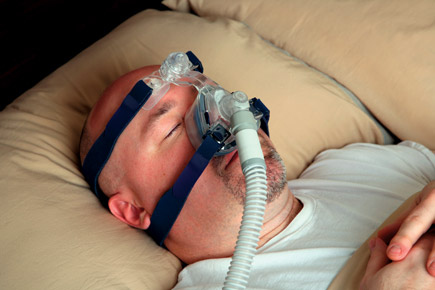Is it time to forgo the handshake?
With hand hygiene compliance rates so low in health care facilities, some are advocating for physicians to avoid shaking hands and considering other ways of greeting patients. Not everyone agrees.
A handshake can convey a lot between physician and patient—warmth, welcome, professionalism. It can also convey pathogens. Despite many initiatives encouraging hand hygiene regimens, compliance remains a challenge among health care workers in general and among physicians in particular.
In part because hand hygiene compliance rates are so low, the medical community is abuzz with ideas for alternatives to the handshake as a way of decreasing transmission of pathogens. One alternative is the fist bump.

Multiple studies indicate that handshakes can transmit organisms such as Clostridium difficile, methicillin-resistant Staphylococcus aureus, vancomycin-resistant Enterococci, and Escherichia coli. Strategies such as the World Health Organization's Five Moments for Hand Hygiene are widely circulated, and hospitals and clinics have undertaken massive initiatives that include training; installing hand sanitizer in hallways, hospital rooms, and examination rooms; and educating patients.
Despite the encouragement, a review of 96 studies on compliance with hand hygiene guidelines in hospital care that appeared in the March 2010 Infection Control and Hospital Epidemiology revealed a median compliance rate with hospital policies of 40% among health care workers and 32% among physicians.
There could be many reasons for this, but the main ones are most likely time constraints and physician memory, said Mark S. Sklansky, MD, chief of the division of pediatric cardiology, medical director of the UCLA Children's Heart Center, and professor of clinical pediatrics at Mattel Children's Hospital UCLA and the David Geffen School of Medicine at UCLA.
“When you need to round on 10, 20, or more patients a day, it takes significant extra time to practice hand hygiene in the way we need to. It's not just a cursory squirt of the gel or putting your hands under a faucet for a few seconds and you're done,” Dr. Sklansky said. “And then other times, people just forget.”
Although research about challenges specific to physicians is limited, a 2012 survey report published by the Wisconsin Department of Health Services and cited in a paper in the February 2013 Implementation Science noted that physicians reported “remembering to perform hand hygiene” and “high workload or feeling too rushed” as their top barriers to hand hygiene compliance.
Michael B. Edmond, MD, FACP, chief quality officer at the University of Iowa Hospitals and Clinics in Iowa City, noted just how vast the challenge is for physicians who work in hospitals. “[When I worked at the Virginia Commonwealth University Health System] we had 15 million hand hygiene opportunities in the hospital every year. It's a big feat to make a behavior common at that level.”
Dr. Edmond also noted the environmental issues physicians and other health care workers in hospitals face. “There's a lot of literature about how the areas around patients are contaminated with pathogens the patient could be carrying. You don't have to touch the patient to contaminate your hands. Just touch something in the patient's environment.”
These challenges are also present in the ambulatory care setting, but likely have lesser impact, Dr. Edmond added.
“We worry about it somewhat less [in ambulatory care] just because the patients aren't as sick as patients in the hospital and don't tend to have as many devices in place like IV lines or other catheters that bypass the body's natural barriers to infection,” Dr. Edmond said. “Nonetheless, the risk is there.”
To shake, or not?
Amid the data and the novel approaches to studying how pathogens spread from hand to hand, the fist bump has captured the imagination of some experts studying ways to curtail infectious diseases.
In a paper published by researchers at the West Virginia University in the December 2013 Journal of Hospital Infection, 2 volunteers washed their hands, then went to a hospital where they shook hands with 20 health care workers. Upon returning to the lab, the volunteers' palms were cultured. The volunteers then washed their hands, returned to the hospital, bumped fists with 20 more health care workers, and returned to the lab where their fists were cultured. Each time the culture plates were incubated at 37° C for 72 hours, and colony-forming units were counted manually. The researchers found that after 72 hours of incubation, the total colonization of the volunteers' palms was 4 times greater than that of the volunteers' fists.
More recently, researchers in the United Kingdom published a paper in the August 2014 American Journal of Infection Control comparing handshakes, high fives, and fist bumps. For each greeting, a participant immersed a sterile-gloved hand into a culture of nonpathogenic E. coli. After the bacteria dried on the glove, the participant exchanged a type of contact greeting with a recipient who also wore a sterile glove. The researchers found that nearly twice as many bacteria were transferred via handshake than via high five and that the fist bump yielded the lowest transmission.
Dr. Sklansky questions whether the fist bump should replace the handshake, however. “It still transmits disease via hand, just less effectively than a handshake. If that's what works for people, that would be a step in the right direction, but if we're going to try to find an alternative, I think we can do better than a fist bump,” he said.
Dr. Sklansky advocates noncontact greetings instead. In a commentary in the June 25, 2014, Journal of the American Medical Association, he and his colleagues cited waving, placing the right palm over the heart, or making the Namaste gesture (hands placed, palms together, in front of the face or chest) as possibilities.
Then there are methods of nonverbal yet friendly contact that are not hand-to-hand, Dr. Sklansky said. “There are other ways to show that you're connecting as human beings, such as eye contact, smiles, [or] touching the patient's shoulder, that are overlooked in the fast-paced ways medicine has evolved,” he said.
But the fast pace of health care and the evolution of health care technology are exactly why the focus should be on physicians improving hand hygiene so as not to lose the handshake, said Marianne M. Green, MD, FACP, associate dean for medical education and competency achievement at Northwestern University's Feinberg School of Medicine in Chicago.
“Time constraints have limited our ability to connect with our patients. When you have 5 yellow alerts letting you know that your patient is due for a mammogram and other screening tests, when your patient is there for a blood pressure check, all of the personal connections like asking about the patient's family—things that used to build rapport with patients—can fall by the wayside,” said Dr. Green. “Simple things like shaking the patient's hand may bring a sliver of that rapport back to the visit.”
Dr. Green and colleagues published a paper in the June 11, 2007, Archives of Internal Medicine noting that 78% of 415 patients in a survey would like their physicians to shake their hands. Dr. Green noted anecdotally that a quick Internet search of reviews of physicians will reveal patients describing, with negativity, cases where their physicians didn't touch them during their visit.
“The fact that patients are taking the time to write this and it's showing up in Google means it's important,” Dr. Green said. “I don't agree with not shaking hands. If the solution is not to shake hands because physicians don't follow hand hygiene protocols, that needs to be followed up with a recommendation to wear gloves during the entire exam. I think that's backwards. We need to focus on getting physicians to follow hand hygiene.”
Improving hand hygiene
Regardless of their stance on handshakes, the experts agree that efforts should continue to improve compliance with hand hygiene policies in the health care setting.
“It's not one or the other, banning handshakes or improving hand hygiene,” said Dr. Sklansky. “We should continue to educate ourselves about the importance of hand hygiene. Once we achieve dramatically better rates of compliance with hand hygiene, then we may reconsider the need for handshake-free zones. But, in the meantime, I think we are doing our patients a disservice if we continue to shake hands in certain health care settings. It's not fair to our patients, who come to the hospital to get better, not to get sick.”
One way to improve compliance with hand hygiene among health care professionals is to indoctrinate medical students early in their education so that hand hygiene becomes second nature to them, said Dr. Green. “Our students start in clinical settings with patients in the second or third week of medical school, and we assess them on whether they washed their hands in front of a patient before sitting down with that patient.”
Enforcing hand hygiene on the wards is another way, Dr. Green said. In her hospital, staff “wander the halls undercover and report students, residents, and faculty who don't engage in hand hygiene.”
“The most important message is that even in 2014, hand hygiene is probably the most important method of infection control in the hospital or health care setting,” said Dr. Edmond. “What I hope is that everyone, one by one, becomes hard-wired for hand hygiene the way we've become hard-wired for wearing seatbelts. It should be something we do automatically and unconsciously.”
In the meantime, physicians should see to their own habits. Both Dr. Sklansky and Dr. Green make it a point to wash their hands in front of their patients.
“After I open the door—which has germs on it—if the patient reaches out to shake my hand, I'll say, ‘Let me wash my hands first,’” said Dr. Sklansky. “Then I can shake the person's hand and proceed immediately to the examination. Then I'll wash my hands again before I leave.”
Doing this for every patient may be time-consuming, but it sends a valuable message in addition to fighting infection, said Dr. Green. “I know I wash my hands after every patient encounter, but my patients don't know that. Washing my hands on coming into the exam room is reassuring to them.”
The bottom line is for physicians to take accountability for the cleanliness of their own hands, said Dr. Edmond. “If everyone was compliant with hand hygiene protocols, [whether to shake hands] wouldn't even be an issue.”



